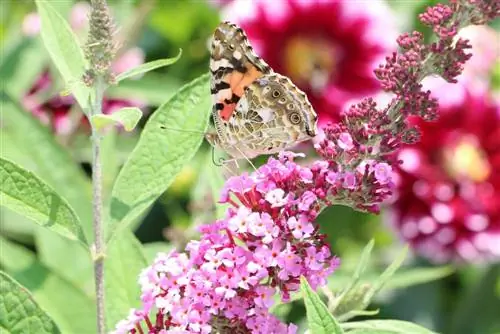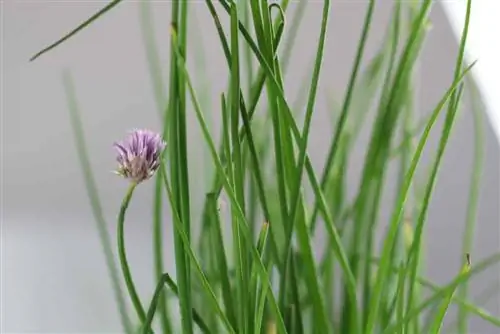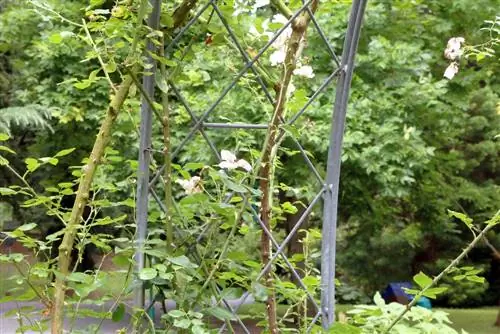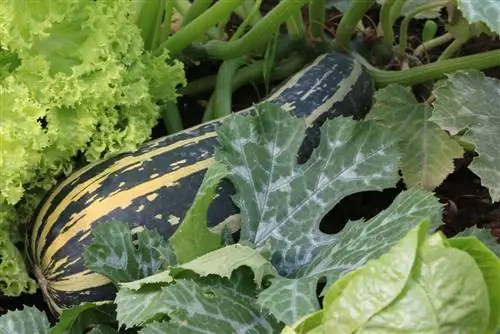- Author admin [email protected].
- Public 2023-12-17 03:39.
- Last modified 2025-01-24 12:45.
The butterfly bush (Buddleja davidii) benefits enormously from pruning as it forms its flowers on the “new wood”. Shortening the dead shoots supports the formation of new branches and the butterfly bush sprouts vigorously. The following applies: the stronger the pruning, the stronger the shoots.
When is the best time to cut?
The butterfly bush is preferably pruned in winter, as pruning in autumn would weaken the plant and therefore make it more susceptible to disease. Pruning in late winter is optimal, but late pruning into March or April is also possible. However, it should be noted that the butterfly bush sprouts from the sleeping eyes and therefore requires more time for sprouting. The following applies: the later you cut back, the later the flowering will begin. If you only cut the buddleia in March or even April, you have to expect delayed flowering until autumn. However, if the butterfly bush is cut in February, it will decorate the garden with its flowers throughout the summer months. When is the optimal time for cutting also depends on the weather conditions:
- on a day that is as frost-free as possible
- not too sunny, but dry
- optimum is a cloudy day
- do not cut in changeable weather
- then it's better to wait before cutting
Note:
When cutting hedges and trees, it is important to take into account the bird breeding season, which lasts from March 1st to September 30th. During this time, to protect the animals, no radical cuts may be made on the plants.
Pruning instructions

First of all, it is necessary to remove all diseased and dead shoots. These not only affect the appearance of the butterfly bush, but can also cause damage to the other shoots. Since the shrub is generally considered to be sensitive to frost, there are usually always dead or frozen branches present. Whether the shoots have suffered frost damage or whether they are still vital can be determined using the vitality test:
- use a sharp, disinfected cutting tool
- scrape the bark of the affected branch superficially
- if the tissue is brown, the branch is dead
- If the tissue is green, the shoot is vital
In order to prevent the shrub from growing too densely, it is necessary to shorten all shoots from the previous year. As a result, the shrub loses two thirds of its original height, but this cut ensures strong growth in spring. The best way to make the cut is as follows:
- remove thin branches completely
- also remove competing and crossing branches
- radically cut back all new shoots
- Short the previous year's flower shoots to around 30 cm
- cut off the branches above the bud
- new shoot buds form at this point
Tip:
Annual pruning is not absolutely necessary, so it is not a problem if you skip it once. However, this means that the bush becomes quite large and produces fewer flowers. This in turn increases the amount of work required for pruning in the following year.
Care after cutting
Every cut on the plant leaves an open wound, making it vulnerable to pests and pathogens. The butterfly bush can close and heal its wounds relatively quickly, but it is advisable to support the healing process, especially with large cuts.
- coat large interfaces with tree wax
- this seals the wound
- make sure the entire wound is covered
- Pathogens and pests cannot penetrate
Stimulate growth after cutting
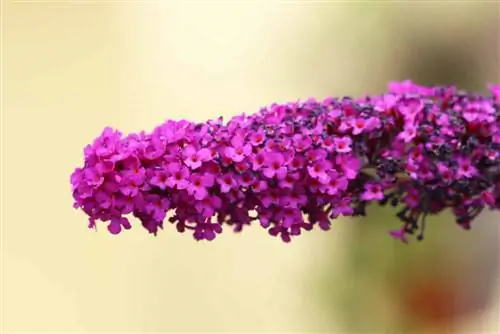
As already mentioned, the butterfly bush forms its new shoots from the sleeping eyes. For this, the shrub not only requires a certain amount of time, but also sufficient strength. In order to stimulate and promote the growth process, it is worth fertilizing after cutting back.
- Mixture of compost and horn shavings
- a layer about 3 cm high
- work the material lightly into the soil
- Alternatively, a mineral-organic complete fertilizer can be used
- then pour with water or nettle manure
For cultivation in the bucket, it is advisable to use a liquid fertilizer. Because this is easier to dose and administer. Before and after fertilizing, you should definitely water with clear water so that the s alt contained in the fertilizer does not damage the roots. This also allows the plant to utilize the nutrients better.
Instructions for the thinning cut
If the butterfly bush is pruned vigorously every year, it forms so-called whorls of branches over the years. These are thick, intertwining branches that can prevent each other from growing. This can lead to the bush becoming bald: Inside the bush there are only bare branches because the new shoots only grow in the upper area. This creates large holes in the foliage, which allow a clear view of the bare branches. Although this is not harmful to the shrub, it does have a massive impact on its appearance. Therefore, regular thinning is advisable, which is as follows:
- cut off old and heavily branched branches
- cut at the base and deep into the branch ring
- best with pruning shears or a folding saw
- also shorten the thin base shoots
Instructions for topiary
While pruning is primarily necessary for the formation of large flowers, topiary is used to create a homogeneous crown structure. There is no fixed time for this, as the topiary can be carried out in both spring and autumn. To adjust the shape and ensure a shapely shrub crown, proceed as follows:
- the cutting height of the shoots is varied
- cut some shoots back heavily
- shorten conveniently positioned branches by only a third
Exception: alternate-leaved buddleia
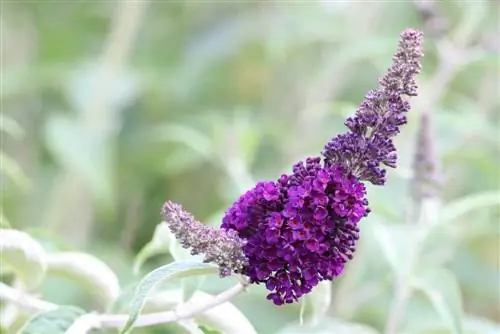
In contrast to the butterfly bush (Buddleja davidii), its relative, the alternate-leaved buddleia (Buddleja alternifolia) is usually not cut. This shrub produces its flowers on two-year-old wood, which is why radical pruning in spring would be extremely counterproductive. Because the alternate-leaved buddleia can put its energy into either seed formation or new bud formation. It is therefore advisable to only give the plant a he alth cut or cut it back gently. When and how you can cut the alternate-leaved buddleia, read here:
- Shrub has grown too big
- or bald from the inside
- remove diseased and old shoots
- best to cut directly on the branch
- cut off spent inflorescences
Remove wilted flowers?
Regularly removing spent inflorescences not only stimulates flower growth, but also extends the flowering period. Because the so-called after-bloom ensures a colorful sea of flowers until autumn. To remove the withered flowers, standard garden scissors are sufficient. Because the shoots are usually still soft and therefore relatively easy to cut.
- is cut off before the seed capsules are formed
- completely remove the withered flower spikes
- nothing should be left standing
- make sure the seeds are not scattered
Tip:
Do not put the withered flowers in the compost, as this could cause the seeds to spread throughout your home garden. It is better to put them in a bag and dispose of them with household waste.
Avoid possible mistakes when cutting
The butterfly bush tolerates radical pruning without any problems and even benefits from it. However, the situation is different with hesitant or “incorrect” cutting. For example, if only the tips are cut, the shoots will branch out in the upper and outer areas. This in turn promotes an unfavorable growth habit because sunlight no longer reaches the interior of the bush. In summary, you should always pay attention to the following points when cutting:
- don't just cut the ends
- Always use the right cutting tool
- this should always be clean, sharp and disinfected
- always work precisely and carefully
- Seal large cuts with tree wax
- dispose of wilted inflorescences in household waste

